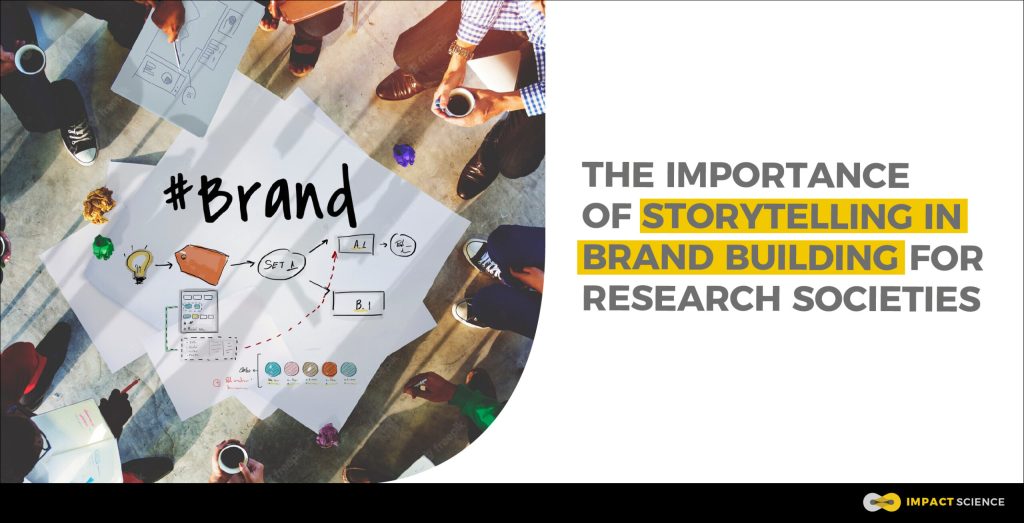Digital transformation has changed the way researchers, publishers, and research societies use new-age media to be seen, heard, and acknowledged. Brand building for a research society involves creating and promoting a strong brand identity and reputation via a strategic and consistent approach. As a part of this strategy, brand storytelling uses a compelling narrative that connects with the target audience and creates a lasting impression.
Why research societies should build their brand
Research societies that focus on brand building can succeed on various fronts.
Credibility and global reputation: A strong brand identity helps to establish the credibility of a research society. By building a brand that is associated with quality, expertise, and professionalism, research societies can attract new members and gain the trust of their existing members. A strong brand will help the world discover the impact of a society’s work and enhance its academic reputation.
Increased membership: Brand building can help research societies grow by encouraging the inflow of new members who align with a society’s research interests, values, and mission.
Meaningful member engagement: Through a clear brand identity and messaging strategy, a society can communicate its mission and values more effectively. This can motivate members to become more involved and active in the society and its diverse initiatives, including advocacy.
Funding and sponsorships: By establishing a strong brand identity and reputation, societies can increase their chances of securing funding and sponsorships for research projects, conferences, and other initiatives.
Positioning brand storytelling in brand building
Research societies can adopt brand building by developing a unique brand identity, implementing a relevant branding strategy, establishing a visual identity, building a strong online presence, leveraging partnerships, and focusing on member engagement. Where does brand storytelling fit in this picture and how can research societies use it?
Culturally, storytelling is as old as civilization itself! Using narratives is one of the oldest approaches humans used to spread important information in an evocative way. Brand storytelling is the art of using a narrative to communicate a brand’s mission and values to its audience. Brand storytelling aims to create a memorable and engaging identity that resonates with the target audience and creates an emotional connection.
Tips for effective brand storytelling by research societies
Today’s fast-paced and technology-driven society has made human connection particularly valuable. Research societies need to establish a deeper connection with their audience to stand out. And in a post-text world, these stories need to be relayed in multiple formats of digital storytelling to inspire communities around the world. Here are some tips for research societies to execute effective brand storytelling.
Identify the right channels: Brand storytelling is more powerful than traditional advertising and marketing. Social networking sites provide brands with a powerful tool to tell their story and connect with their audience in a more meaningful way. Research societies should leverage the reach, engagement, virality, and analytics of these platforms to build a strong and authentic brand story.
Know your audience: Know your target audience and their needs, interests, and preferences to tailor your message and make it relevant to them.
Develop an effective narrative: A brand story should have a clear beginning, middle, and end. The narrative should be cohesive and flow well. People are more likely to remember a story that evokes an emotional response. Creating a story that sparks interest or connects with the audience on an emotional level can go a long way to this end.
Make it memorable: Instead of telling the audience what a society’s brand is all about, show them through storytelling. Using vivid descriptions and examples to paint a picture of your brand’s values will make the brand story memorable and leave a lasting impression on the audience.
Cross-promote your brand: Cross-promotion is a terrific way to enhance brand storytelling efforts and expand reach. One way to do this is by co-creating content. A society can work with universities or even other societies and journals to tell a compelling story that resonates with overlapping audiences. The story may be shared via blog posts, videos, or social media campaigns. Another approach is to partner with academic influencers who align with a research society’s profile and have a following that overlaps with the research society’s target audience.
Examples of brand storytelling by research societies and publishers
American Chemical Society (ACS): ACS uses brand storytelling to communicate the impact of chemistry on society. Their messaging emphasizes the role that chemistry plays in everything from health and medicine to energy and the environment. By highlighting real-world examples of how chemistry is making a difference, ACS can connect with audiences on an emotional level and showcase the value of their work.
On its LinkedIn page, for instance, it showcases its position as the world’s largest scientific society and a leading source of authoritative scientific information. Its 150,000-strong membership includes chemists and chemical engineers from across globe, who are engaged in “evolving chemistry enterprise.” On its Facebook page, it pithily states its role as “One of the world’s largest scientific societies and a leading source of authoritative scientific info.”
American Psychological Association (APA): APA’s brand storytelling focuses on the power of psychology to improve people’s lives. Their messaging emphasizes the role that psychologists play in addressing social issues like mental health, education, and diversity. By highlighting the positive impact that psychology can have on society, APA positions itself as a trusted authority on these issues and attract new members and partners. On its LinkedIn and Facebook pages, APA’s mission to advance the creation, communication, and application of psychological knowledge to benefit society and improve people’s lives is well showcased.
These are just a few examples demonstrating how academic societies use brand storytelling to communicate their mission, values, and impact to a broader audience. While not entirely a brand storytelling example, and not even by a research society, Springer’s storytelling initiative Springer Storytellers has some valuable takeaways for research societies to build on. This involves events where personal stories narrated by researchers in front of a live audience. The stories are made available as podcasts or written posts on a website beforetheabstract.com, freely accessible to the public.
To wrap up
Brand storytelling involves sharing the narrative behind a brand and its significance consistently across all communication. It is a powerful tool that can help academic societies build strong relationships with their members and audience, establish their unique identity, and create a competitive advantage in the academic landscape. By highlighting the emotional and practical significance of their work, academic societies can build stronger connections with stakeholders and even inspire young people to pursue careers in these fields.









